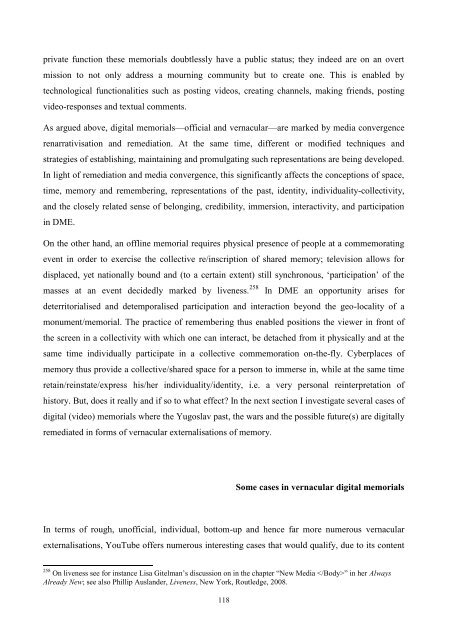UNIVERSITY OF NOVA GORICA GRADUATE SCHOOL ...
UNIVERSITY OF NOVA GORICA GRADUATE SCHOOL ...
UNIVERSITY OF NOVA GORICA GRADUATE SCHOOL ...
Create successful ePaper yourself
Turn your PDF publications into a flip-book with our unique Google optimized e-Paper software.
private function these memorials doubtlessly have a public status; they indeed are on an overt<br />
mission to not only address a mourning community but to create one. This is enabled by<br />
technological functionalities such as posting videos, creating channels, making friends, posting<br />
video-responses and textual comments.<br />
As argued above, digital memorials—official and vernacular—are marked by media convergence<br />
renarrativisation and remediation. At the same time, different or modified techniques and<br />
strategies of establishing, maintaining and promulgating such representations are being developed.<br />
In light of remediation and media convergence, this significantly affects the conceptions of space,<br />
time, memory and remembering, representations of the past, identity, individuality-collectivity,<br />
and the closely related sense of belonging, credibility, immersion, interactivity, and participation<br />
in DME.<br />
On the other hand, an offline memorial requires physical presence of people at a commemorating<br />
event in order to exercise the collective re/inscription of shared memory; television allows for<br />
displaced, yet nationally bound and (to a certain extent) still synchronous, ‗participation‘ of the<br />
masses at an event decidedly marked by liveness. 258 In DME an opportunity arises for<br />
deterritorialised and detemporalised participation and interaction beyond the geo-locality of a<br />
monument/memorial. The practice of remembering thus enabled positions the viewer in front of<br />
the screen in a collectivity with which one can interact, be detached from it physically and at the<br />
same time individually participate in a collective commemoration on-the-fly. Cyberplaces of<br />
memory thus provide a collective/shared space for a person to immerse in, while at the same time<br />
retain/reinstate/express his/her individuality/identity, i.e. a very personal reinterpretation of<br />
history. But, does it really and if so to what effect? In the next section I investigate several cases of<br />
digital (video) memorials where the Yugoslav past, the wars and the possible future(s) are digitally<br />
remediated in forms of vernacular externalisations of memory.<br />
Some cases in vernacular digital memorials<br />
In terms of rough, unofficial, individual, bottom-up and hence far more numerous vernacular<br />
externalisations, YouTube offers numerous interesting cases that would qualify, due to its content<br />
258 On liveness see for instance Lisa Gitelman‘s discussion on in the chapter ―New Media ‖ in her Always<br />
Already New; see also Phillip Auslander, Liveness, New York, Routledge, 2008.<br />
118

















